“Liberty to all…clears the path for all—gives hope to all.”—Abraham Lincoln
Why this Book? Why will it matter to kids?
Lincoln’s legacy includes a multitude of groundbreaking and far-reaching decisions. As Peggy reflects in the text, “[Lincoln] always seemed happiest when solving someone else’s problem.” Readers learn of his hard-won agricultural legacy. Though Lincoln did not love farming, he had the foresight to realize and appreciate its value and importance to our nation’s people and our nation’s future.
Levels and Layers of Learning
Acceptance, compassion, concern, connection, courage, creativity, dedication, diligence, effort, empathy, empowerment, encouragement, fortitude, friendship, generosity of spirit, gratitude, helpfulness, hope, humility, inspiration, integrity, justice, kindness, loyalty, passion, perseverance, persistence, perspective, resilience, resourcefulness, respect, self-assurance, self-awareness, self-reliance, tenacity, trustworthiness, understanding
American history, science, English Language Arts
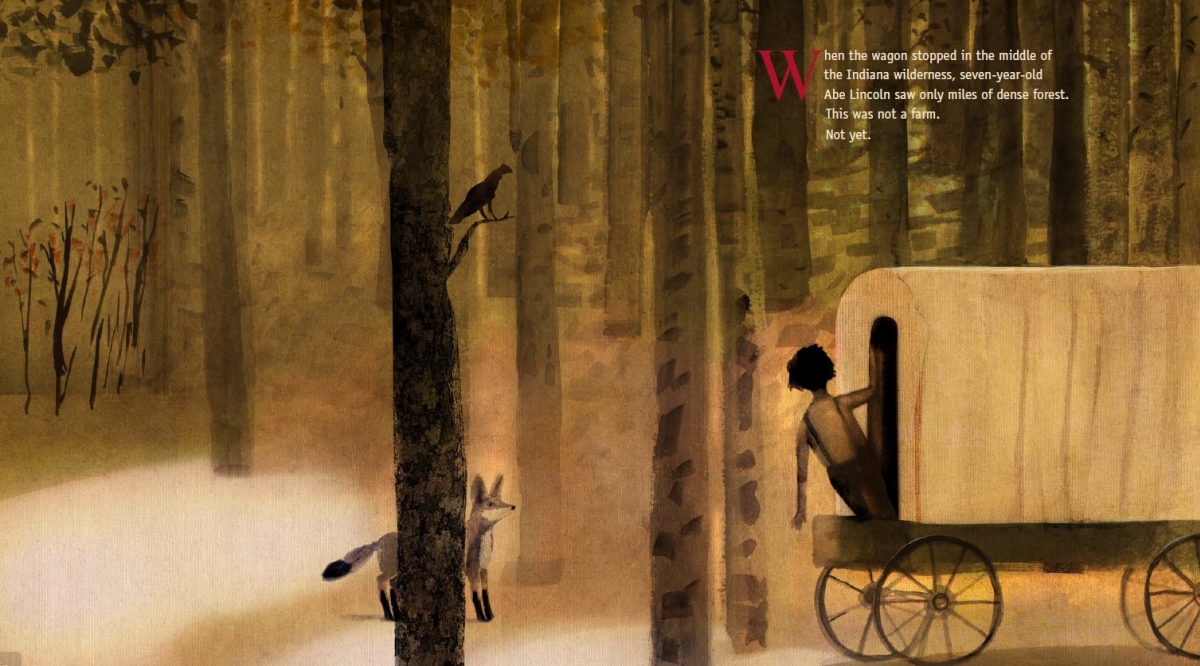
Using This Book in the Classroom
Hit the Ground Running
Ready Resources for Educators, Homeschoolers, and Parents
Classroom Activities and Lesson Plans by Stephanie Bearce; includes Life of Lincoln KWL, Lincoln Timeline, Campaign for Lincoln, Crossword, and Word Search.
Lessons for Abraham Lincoln Clears a Path by BekkaIsraelsen, Utah Agriculture in the Classroom
Write Away!
Ideas to prompt writing
Discuss onomatopoeia, citing examples from the text. See also “Thank You, Sleep!” by Carolyn Dee Flores; a poem in Thanku: Poems of Gratitude, edited by Miranda Paul, illustrated by Marlena Myles. As a group, generate other examples of onomatopoeia. Following Peggy’s’ pattern in Lincoln Clears a Path of choosing three words to convey action, have students describe a favorite activity using onomatopoeia.
See also, Peggy’s worksheet: Begin With a BANG!
Worksheet: Finding Your Single Thread offers an activity on sharpening main ideas in writing; created by Peggy Thomas.
Discuss the meaning of Lincoln’s words, “I want it said of me by those who know me best that I always plucked a thistle and planted a flower where I thought a flower would grow.” Ask children to write about a way that they can “plant a flower where a flower would grow.” See Peggy’s Clear a Path Project, a kindness initiative inspired by Lincoln.
Peggy found this reflection and placed it on a bulletin board in her office: “Every kind word makes me stronger, Every kind deed sets me free.” She says, “I believe that even the smallest act of kindness can clear a path to a more peaceful world.” Ask students to respond in writing to the quotation. How can they put Peggy’s words into action?
In the Author’s Note, Peggy lists several websites to visit for further information about Lincoln. Have students team up to explore the websites. Write a summary of the highpoints of the site. What did you learn that you didn’t know? What did you find out that led to more questions about Lincoln?
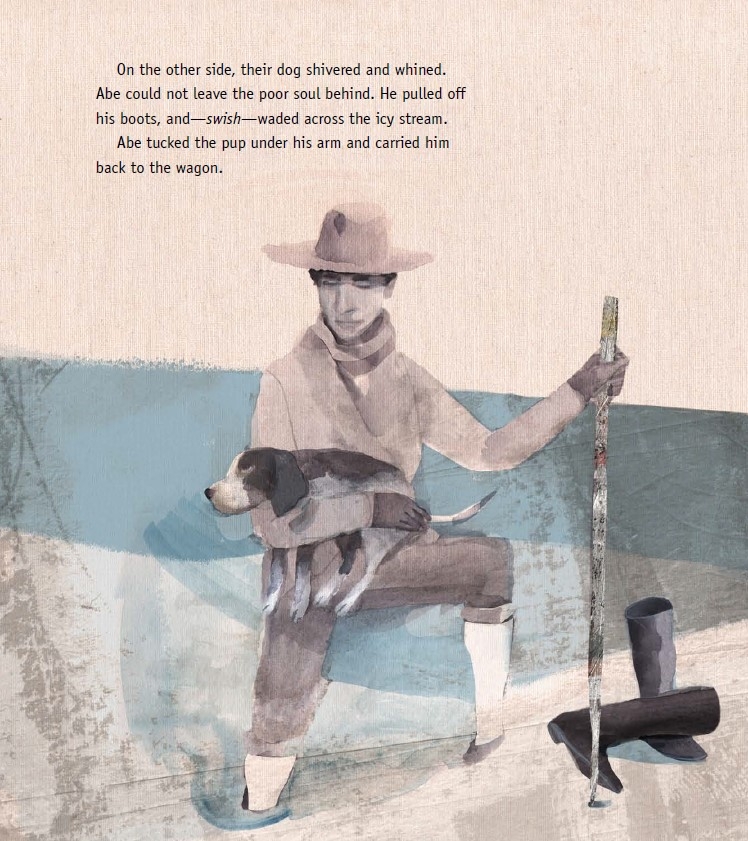
Poetry Break
Related poetry to recite before or following the reading of this book
Poetry fits perfectly into brief moments in the day—from morning opening to lining up for lunch; from transitioning between subjects to zipping up backpacks at dismissal. Reading a poem typically takes less than a minute, yet it can introduce or reinforce a concept, celebrate language, exemplify rhythm, enhance vocabulary, expand understanding, increase attention span, initiate reflection, or summon a giggle. And, poetry soothes the spirit.
- The Superlative A. Lincoln: Poems About Our 16th President by Eileen R. Meyer, illustrated by Dave Szalay
- “Thank You, Sleep!” poem by Carolyn Dee Flores; Thanku: Poems of Gratitude, edited by Miranda Paul, illustrated by Marlena Myles (onomatopoeia; see Writing Activity above)
And Then There’s This…
Enrichment activities, related books, online resources, craft projects, and ideas for further study
Clear a Path Project by Peggy Thomas is all about kindness, inspired by Lincoln. Lesson plan included.
Find a unit on Lincoln featuring books, activities, writing prompts, and online resources in The Read-Aloud Scaffold: Best Books to Enhance Content Area Curriculum, Grades Pre-K-3 by Judy Bradbury; pp.122-125.
Related Books of Interest: A Library of Books about Lincoln
The books listed here offer insight into various aspects of Lincoln’s life and work.
Abe Lincoln at Last! Magic Tree House #47 by Mary Pope Osborne, illustrated by Sal Murdocca
Abe Lincoln at Last! Magic Tree House Fact Tracker by Mary Pope Osborne and Natalie Pope Boyce, illustrated by Sal Murdocca
Abe Lincoln Crosses A Creek: A Tall, Thin Tale by Deborah Hopkinson, illustrated by John Hendrix
Abe Lincoln: His Wit and Wisdom from A-Z by Alan Schroeder, illustrated by John O’Brien
Abe’s Honest Words: The Life of Abraham Lincoln by Doreen Rappaport, illustrated by Kadir Nelson
Abraham by Frank Keating, illustrated by Mike Wimmer
Abraham Lincoln by Amy L. Cohn and Suzy Schmidt, illustrated by David A. Johnson
Abraham Lincoln Comes Home by Robert Burleigh, illustrated by Wendell Minor
Dancing Hands: How Teresa Carreño Played the Piano for President Lincoln by Margarita Engle, illustrated by Rafael López
He Has Shot the President! by Don Brown
Honey, The Dog Who Saved Lincoln by Shari Swanson, illustrated by Chuck Groenink
Lincoln and Douglass: An American Friendship by Nikki Giovanni, illustrated by Bryan Collier
Lincoln and Grace: Why Abraham Lincoln Grew a Beard by Steve Metzger, illustrated by Ann Kronheimer
Lincoln and His Boys by Rosemary Wells, illustrated by P. J. Lynch
Lincoln Tells a Joke: How Laughter Saved the President (And the Country) by Kathleen Krull and Paul Brewer, illustrated by Stacy Innerst
Long, Tall Lincoln I Can Read! 2, by Jennifer Dussling, illustrated by Chin Ko
Looking at Lincoln by Maira Kalman
Mr. Lincoln’s Boys: Being the Mostly True Adventures of Abraham Lincoln’s Trouble-Making Sons, Tad and Willie by Staton Rabin, illustrated by Bagram Ibatoulline
Our Abe Lincoln by Jim Aylesworth, illustrated by Barbara McClintock
Vinnie and Abraham by Dawn FitzGerald, illustrated by Catherine Stock
For older readers:
Abraham Lincoln & Frederick Douglass: The Story Behind An American Friendship by Russell Freedman
Abraham Lincoln The Writer: A Treasury of His Greatest Speeches and Letters, compiled and edited by Harold Holzer
Father Abraham: Lincoln and His Sons by Harold Holzer
History’s All-Stars: Abraham Lincoln by Augusta Stevenson, illustrated by Jerry Robinson
Lincoln: A Photobiography by Russell Freedman (Newbery Award)
Lincoln through the Lens: How Photography Revealed and Shaped an Extraordinary Life by Martin W. Sandler
The Lincolns: A Scrapbook Look at Abraham and Mary by Candace Fleming
The President is Shot! The Assassination of Abraham Lincoln by Harold Holzer
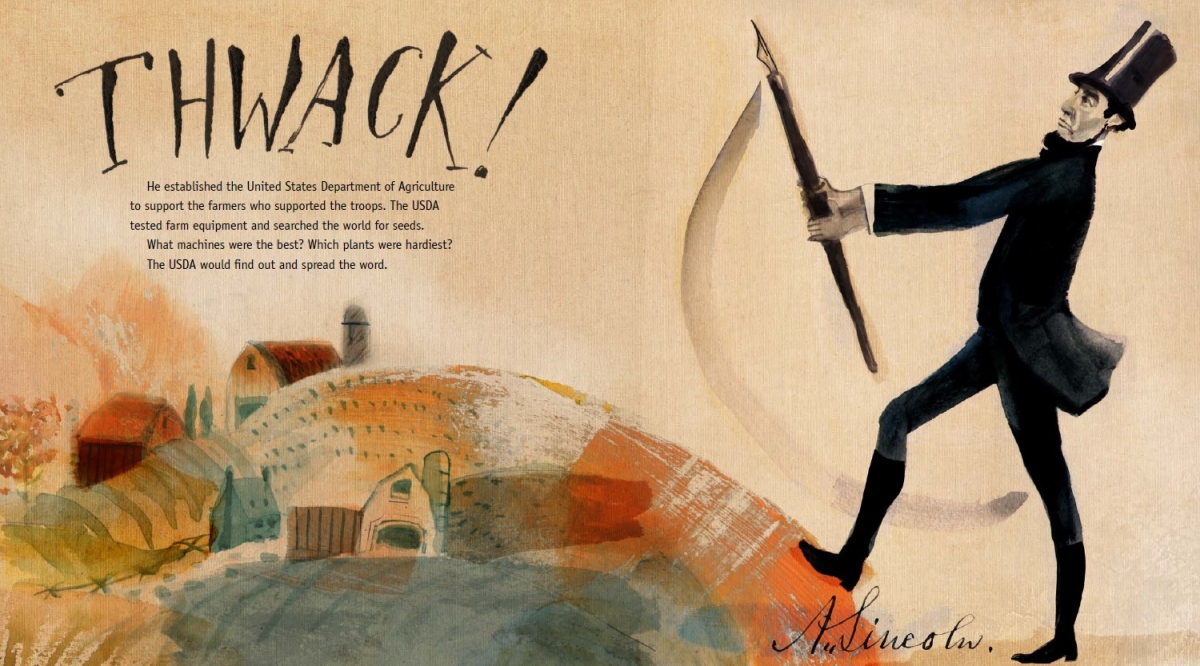
Meet the Author
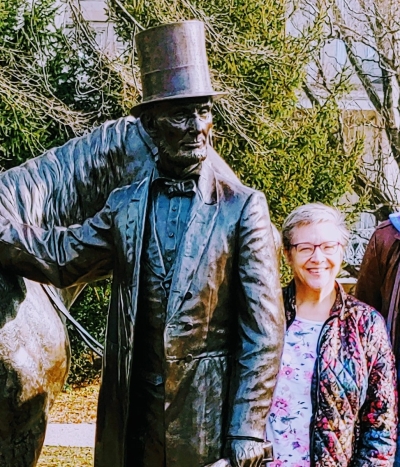
Backstory: Q & A with Peggy Thomas
Judy Bradbury: How did you come to write Lincoln Clears a Path: Abraham Lincoln’s Agricultural Legacy? What kernel seeded its creation?
Peggy Thomas: Previously, I had written Farmer George Plants a Nation and Thomas Jefferson Grows a Nation [for Calkins Creek] which highlight a president and his agricultural interests. I chose Lincoln to fill out a trilogy.
JB: Tell about one hurdle you experienced in the creation of Lincoln Clears a Path: Abraham Lincoln’s Agricultural Legacy or provide a memorable (or humorous!) anecdote related to the making of this book.
PT: My biggest hurdle was having a protagonist who didn’t like farming. That’s not good for a farm-focused book. Although Lincoln spent his early years on his father’s farm and helping neighboring farmers, he was known for saying that his father taught him how to farm, but never taught him how to love farming. I had to dig into Lincoln’s character to figure out why he had the greatest impact on American farming than any other president.
JB: You thread recurring words throughout this picture book biography to convey what mattered to Abraham Lincoln and what drove his actions: Thwack! Swish! Thwump! Yah. How did you land on this method to tell Lincoln’s story?
PT: Once I had my through-line of clearing a path, I started to write. The first path was through the Indiana woods to open the Lincoln’s farm. That’s when I heard an ax – Thwack! A scythe – Swish! The pop of a tree stump – Thwump! And young Lincoln urging oxen – Yah! Although they were the literal sounds of clearing one kind of path, I also used them figuratively to signify other kinds of path clearing. It was a fun way to reinforce a theme.
JB: Shelves of books for children centering on Abraham Lincoln exist. How did you decide what to emphasize in your biography of this great hero?
PT: Writing about someone as famous as Lincoln is daunting because every aspect of his life has been analyzed. But as this book proves, every writer brings something new to the table. I chose agriculture because it had to be similar to the other two books. But during the research process “clearing a path” chose me.
JB: What did you learn from creating Lincoln Clears a Path: Abraham Lincoln’s Agricultural Legacy?
PT: I learned that during the Civil War Lincoln had the foresight to plan for the future. In the summer of 1862, while his world was literally falling down around him, he created the USDA, signed the Homestead Act, the Pacific Railway Act, and established Land-grant colleges. That doesn’t sound very exciting, except that it was classic Lincoln. He spent his entire life clearing a path for others, and with this legislation he cleared the path for the U.S. to become the breadbasket of the world and a global power.
JB: What would surprise readers to learn about you or about the creation of Lincoln Clears a Path: Abraham Lincoln’s Agricultural Legacy?
PT: I almost quit—a few times—while writing this book. I just could not get over that Lincoln-hated-farming hurdle. Because it was part of a trilogy, there was already a predetermined structure, focus and theme. I could not and would not cram a character into a plot that didn’t fit. I attacked this project from several angles and nothing was working, so, I went back to my research. Hopefully Lincoln would tell me in his own words what the connection was. And he did. In several letters and speeches, he used the phrase “clear a path” when talking about helping people. That was it! I could see a path through the woods, and a path toward prosperity, and a path toward freedom. The pieces fell into place. So–don’t give up no matter how tough it gets.
JB: What do you hope readers will take away from Lincoln Clears a Path: Abraham Lincoln’s Agricultural Legacy?
PT: More than anything, I hope readers think about all the ways they can help others. We may not all be able to clear a path for the entire country, but we all can shovel a neighbor’s sidewalk, or donate to a food pantry, or send cards to soldiers, or take soup to someone who is sick. Just think–What would Lincoln do?
JB: How do you see Lincoln Clears a Path: Abraham Lincoln’s Agricultural Legacy connecting to curriculum?
PT: I hope educators will not only incorporate this book into a history lesson on Lincoln, but also use it in writing class as an example of figurative language and the power of onomatopoeia. It can also open conversations about agriculture and where our food comes from. More importantly, I’d like to see this book used to jump start a kindness project like the Clear a Path Project on my website.
JB: What’s up next?
PT: I have a mid-grade biography coming out next year about Norman Borlaug, a kid who grew up on an Iowa farm and became an agriculturalist who battled famine in Mexico, the Middle East and India. It’s called Hero for the Hungry (Feeding Minds Press).
JB: What is one question you wish I had asked, and what is your answer?
PT: Did anyone clear a path for you? – and I’d say, yes. I’d like to thank Judy Bradbury for clearing a path for me to talk about Lincoln and share my writing journey. Thanks!
About the Illustrator
The illustrations in Lincoln Clears a Path: Abraham Lincoln’s Agricultural Legacy were created by award-winning artist, Stacy Innerst.
Over to You…
What is your favorite little known fact about Abraham Lincoln?
News and Updates
Find virtual events and interviews celebrating the launch of Book 1 in the Cayuga Island Kids series elsewhere on my website. If you’re curious about my dance recital costume when I was the age of my characters, check out James Preller’s interview!
Read “How Empathy Can Boost Creativity in Kids” for insight into the link between empathy and creativity, and why cultivating empathy should be a lifelong pursuit.
Every Child a Reader’s Spring Children’s Book Week takes place May 3-9. Find resources and information on how to receive posters and access to free materials. The 2021 slogan is Reading is a Superpower, and the poster art creator is author and illustrator Bryan Collier. Find an interview with this esteemed award-winning illustrator of All Because You Matter on this Children’s Book Corner post.
Bank Street College of Education announced the winners of the Josette Frank Award, the Flora Stieglitz Straus Award for Younger and Older Readers, and the Claudia Lewis Award for Younger and Older Readers. Presented annually, these awards recognize outstanding works of children’s literature in the genres of fiction, nonfiction, and poetry respectively.
Celebrating the 35th anniversary of the Ezra Jack Keats Award, the Ezra Jack Keats Foundation, in partnership with the de Grummond Children’s Literature Collection at the University of Southern Mississippi, announced the 2021 winners. The Ezra Jack Keats Award honors exceptional early career authors and illustrators for portraying the multicultural nature of our world.
Thanks to the benevolence of museums across the world, virtual visitors can tour magnificent treasures from the comfort of their homes. Learn more in this Library Journal article.
Final Thought
“Children matter. They have their inner joys and inner sorrows. They see everything. They know everything, but they don’t always understand it…We owe children the truth and strength to encourage them to know their own landscape” ~ Patricia MacLachlan, SCBWI Winter Conference 2021

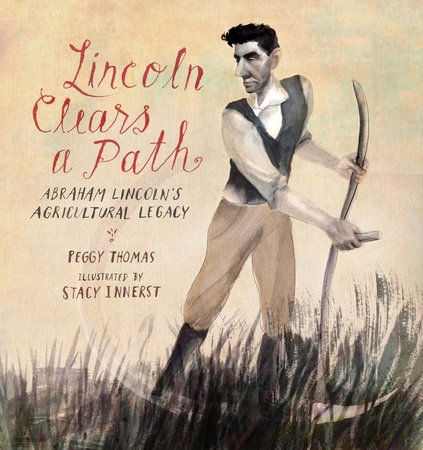
Congratulations to Peggy on finding a unique way to present someone who is one of the most written about people in US history. The book sounds fun and informative, and her Clear a Path Project shows a way that absolutely anyone can help make the world a better and/or kinder place. Well done, Judy, in clearing the path for Peggy to tell us about her book!
Looks like another wonderful book, Peggy, with beautiful illustrations as well. And I actually like knowing that Lincoln wasn’t thrilled with farming but still did right by farmers and our country in the end. What a remarkable man!
Thanks for digging up this new story about Lincoln to share with readers, Peggy.
And, thank you, Judy, for putting together all this information. I’m glad no thwacking was needed to make this interview happen.